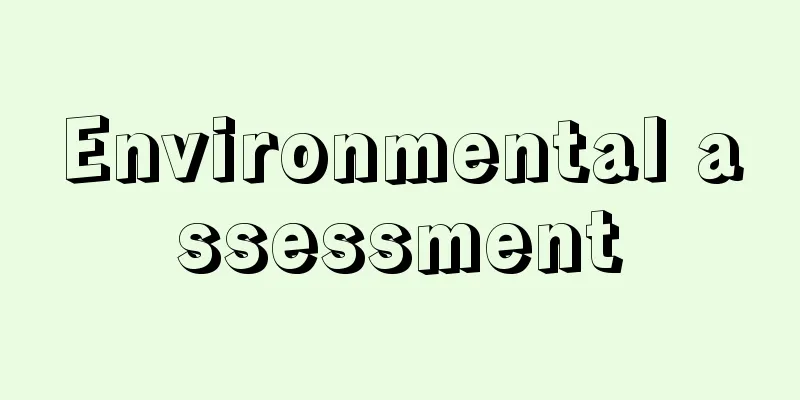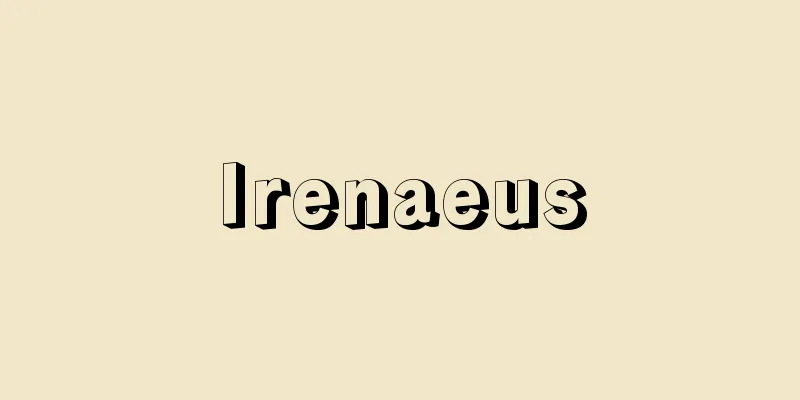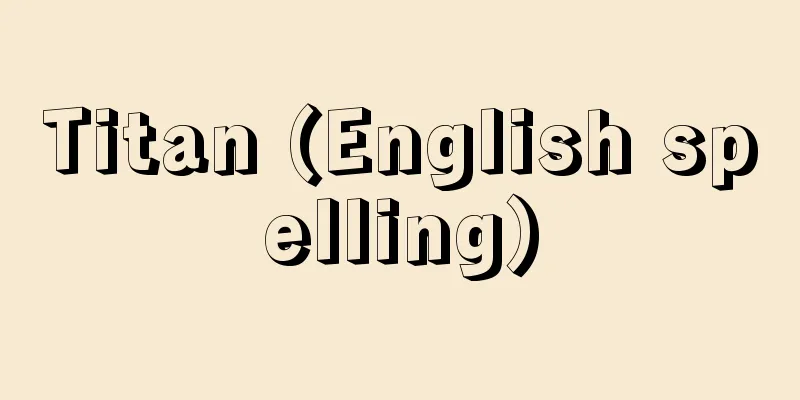Environmental assessment

|
Abbreviated as EA. When planning, undertaking or other activities that affect the environment, the current state of the environment is evaluated (environmental assessment), then various alternatives are considered, the impact of each alternative on the environment is evaluated (environmental impact assessment), the best alternative is selected, and then during the implementation stage, monitoring is performed to see if the results are as predicted and evaluated, and if not, review and correction is performed. This is an attempt to incorporate environmental benefits into the decision-making process, based on the reflection that serious pollution and environmental destruction have been caused by focusing only on economic benefits in various undertakings. This is an ideal form, but in reality, many of the systems that have been institutionalized are insufficient, with only a limited number of target projects and predictions/evaluation items, and no consideration of alternatives or post-facto monitoring. There are two methods for incorporating the results of environmental impact assessments into the policy-making process: procedural laws that simply provide material for policy decisions, and regulatory laws that serve as the criteria for approval and authorization. The first country to enact this system was the National Environmental Policy Act (1969) in the United States, and other countries followed suit, with Japan being the last country in the OECD (Organization for Economic Cooperation and Development). [Yasuhito Abe] Legislation in JapanIn Japan, a rudimentary environmental assessment system, which could be called a pre-pollution survey, was established in the 1972 Cabinet decision "Regarding environmental conservation measures for various public works projects," the Factory Location Law, the Public Water Surface Reclamation Law, the Port and Harbor Law, and the Seto Inland Sea Environment Conservation Special Measures Law, and pollution prediction surveys were carried out for the development of industrial bases such as Kansai International Airport and the eastern part of Tomakomai. The Environment Agency (now the Ministry of the Environment) proposed an environmental impact assessment bill based on the report of the Central Pollution Control Council (now the Central Environment Council), but due to opposition from business agencies and the financial world, it was not submitted to the Diet for a long time, and the bill finally submitted in 1981 was ultimately scrapped in 1983. The reasons for opposition were that the technical methods for environmental impact assessment had not been established, and that the system would increase lawsuits and cause delays in public works projects. Instead, the government decided in August 1984 to carry out environmental impact assessments through administrative measures (the so-called Cabinet Assessments), and the Ministry of Construction (now the Ministry of Land, Infrastructure, Transport and Tourism) issued a notice in April 1985 calling for environmental impact assessments to be carried out in advance when building roads or dams of a certain size. However, there were many problems with this outline assessment, such as the small number of projects it covered, insufficient public participation, and no way to challenge it in court, so legislation was needed. On the other hand, local governments, unable to wait for national legislation, began to institutionalize environmental impact assessments, and many local governments, including Kawasaki City, Hokkaido, Tokyo, and Kanagawa Prefecture, had already enacted ordinances or guidelines (internal administrative rules). There are precedent cases in which provisional injunctions were granted to stop the construction of sewage treatment plants and garbage disposal plants that had not conducted environmental impact assessments. Subsequently, provisions related to the promotion of environmental impact assessments were included in the Basic Environment Law enacted in November 1993, and the Basic Environment Plan of December 1994 set out government policy stating, "The future of the environmental impact assessment system will undergo necessary review, including the possibility of enacting legislation." In line with this policy, research was conducted on the status of system implementation and technical methods both in Japan and overseas, and the results were submitted to the Central Environment Council for consultation. In February 1997, the Council submitted a report to the Prime Minister calling for legislation, and the Environmental Impact Assessment Act (Environmental Assessment Act) was finally enacted in June of the same year and came into effect in June 1999. Below, the contents of this law will be explained along with the steps of environmental impact assessment. [Yasuhito Abe] Target projects and evaluation itemsFirst, the projects that are subject to this law are limited to 13 projects that are large in scale and likely to have a significant impact on the environment (roads, rivers, railways, airports, power plants, final waste disposal sites, landfill and reclamation of public water surfaces, land readjustment projects, new housing and urban development projects, industrial park construction projects, new urban infrastructure development projects, distribution business park construction projects, etc.) among those in which the national government is involved (in addition to projects directly carried out by the national government, projects run by special corporations in which the national government has invested, and projects for which the national government has granted licenses, approvals, etc., or subsidies). These are divided into Type 1 projects, which require an environmental assessment depending on the scale, and Type 2 projects, which are smaller in scale than Type 1 projects but are individually judged to require an assessment if they are likely to have a large impact on the environment. When making this judgment, the opinion of the prefectural governor of the project area is to be heard (Article 4 of the Environmental Impact Assessment Law). This procedure for determining whether an assessment is necessary is called screening. Even if the businesses are not subject to these laws, screening may be required for businesses that are located in sensitive areas such as wetlands or high mountains, such as recreational facilities, sewage treatment plants, soil and stone mining, and large-scale/high-rise buildings. Alternatively, it may be necessary to implement screening in accordance with local government ordinances. In the past, the survey and evaluation items for assessments were usually the seven typical types of pollution (air pollution, water pollution, soil pollution, noise, vibration, land subsidence, and odors) and natural environment items (topography, geology, flora and fauna, and natural scenery). However, it has become necessary to evaluate a wider variety of items, such as amenity (comfort), biodiversity, sunlight, waste, satoyama (secondary natural areas that are intermediate between virgin natural areas and urban areas and include familiar woodlands, rice fields, reservoirs, green spaces, and grasslands that are reminiscent of the original landscape of the Japanese people), and tidal flats. The law also stipulates that the survey, evaluation items, and evaluation methods be clarified in the environmental impact assessment methodology, and that the items and methods be selected after hearing the opinions of governors, mayors, and residents (scoping, Articles 5 to 11 of the same law). This allows for flexible methods to be adopted according to the characteristics of the region and the project. The Ministry of the Environment publishes a general outline of evaluation items, methods, etc. as "Basic Points," and based on this, the competent ministries and agencies in charge of each type of project publish more specific guidelines. [Yasuhito Abe] Preparation of memorandum and proceduresProject operators must conduct actual surveys, predictions, and evaluations, and compile the results into an "Environmental Impact Assessment Preparation Document" (Preparation Document) (Articles 14 to 20 of the same Act). The operator will make a public announcement to that effect and make the draft document available for public inspection (wide publicity) for one month. In addition, an explanatory meeting will be held regarding the draft document. Anyone with opinions about the contents of the draft document from the standpoint of environmental conservation may submit a statement of opinion regarding it within two weeks after the end of the public inspection period. The operator will also send the draft document to the relevant local governments, and after hearing the opinions of the mayors of the relevant areas, the prefectural governor will submit a statement of opinion within 120 days (within 150 days if difficult on-site investigations, etc. are necessary). This preparatory document will be evaluated not only on the numerical value of whether or not environmental standards are met, but also on whether or not measures have been taken to avoid or reduce the impact on the environment as much as possible. Therefore, it is necessary to include details of the comparative study of multiple options for environmental conservation, and if it is impossible to reduce the impacts, the implementation of compensatory measures as necessary. However, Japan's Environmental Impact Assessment Act has a flaw in that it does not explicitly require the consideration of such alternative options. The project operator then takes these opinions into consideration and prepares an "Environmental Impact Assessment Report" (Articles 21 to 24 of the same Act), and submits this report to the competent authority responsible for granting permits and licenses. If necessary, the Minister of the Environment will then submit a letter of opinion on environmental conservation to the relevant competent authority (within 45 days), and based on this, the competent authority will issue a letter of opinion to the business operator within 90 days. Taking these opinions into consideration, the business operator will reexamine the evaluation report (and conduct additional investigations, etc. if necessary), revise it, and then prepare a final evaluation report, which will be announced and made available for public inspection (for one month) (Articles 25 to 27 of the same Act). In order to ensure the effectiveness of the assessment system, even in the case of a development project carried out by the national government, construction cannot commence until the publication of the assessment report. Only after the publication can construction commencement take place (Article 31 of the said Act). On the other hand, for businesses that require approval, even if the individual laws do not contain provisions for environmental considerations, the contents of this EISA will be examined when deciding whether to permit or approve the business to see whether appropriate consideration has been given to environmental conservation (so-called cross-cutting clauses). Conditions may also be attached if necessary (Articles 33 to 35 of the same law). Furthermore, even after the publication of the evaluation report, the environmental assessment procedure may be carried out again if there are special circumstances that make it necessary, such as changes in the environment of the target area or its surroundings (Article 32 of the same Act). [Yasuhito Abe] Environmental assessment issuesAssessments conducted by local governments are limited to those that are not subject to national government target projects. However, it is possible for local governments to stipulate in ordinances that they will hold review committees and public hearings to gather opinions as part of the national government's assessment procedures (Articles 60 and 61 of the same law). In this regard, local governments that have enacted assessment ordinances more proactively than the national government are confused, as they will have to roll back their policies due to the enactment of national law. Although the Environmental Impact Assessment Law is a breakthrough in Japan, it still has many problems. First, because the project operator carries out the assessment, it is easy to reach the conclusion that the impact will be minor. Also, the assessment is carried out at a specific project stage, and there are cases when it is already too late to adopt alternative plans. Assessments at an earlier planning stage (planning assessments) are needed, and in order to protect the environment of an entire country or region, it is desirable to institutionalize strategic assessments with a long-term perspective, in which assessments are conducted not only for individual projects but also for all national plans and long-term plans. Although numerous opportunities are provided to hear the opinions of residents, experts, and relevant local governments, some feel that in practice there are not enough opportunities for residents' opinions to be reflected. Article 7 of the Supplementary Provisions stipulates that the law will be reviewed 10 years after its enactment, and in 2010, a revised bill incorporating a strategic assessment was prepared and submitted for deliberation in the Diet. However, it was not passed during the ordinary Diet session, and the law was left under continued review. However, prior to this, the Basic Act on Biodiversity (Act No. 58 of 2008) introduced strategic assessments at the planning stage. In other words, based on the premise that biodiversity exists by maintaining a delicate balance and that once damaged it is difficult to restore, the act stipulates that the government "shall take necessary measures, taking into account the characteristics of the project" so that business operators who carry out projects that may affect biodiversity "conduct a survey, prediction or evaluation of the impact on biodiversity at the planning stage and, based on the results, give due consideration to the conservation of biodiversity related to the project" (Article 25 of the same act). [Yasuhito Abe] "Environmental Assessment from the Citizen's Perspective" by Shimazu Yasuo (1997, Japan Broadcasting Publishing Association)" ▽ "Environmental Assessment Study Group of the Environment Agency, Japan's Environmental Assessment, 1998 Edition (1998, Gyosei)" ▽ "Environmental Law and Policy Association, New Environmental Assessment Law" (1998, Commercial Law Research Association) [Reference items] | | | | | | Airport | | | | | | Land subsidence | | | | | | | | | | | | | |Source: Shogakukan Encyclopedia Nipponica About Encyclopedia Nipponica Information | Legend |
|
略称EA。環境に影響を与える計画や事業その他の行為に際し、環境の現況を評価し(環境評価)、ついで各種の代替案を考えて、それぞれの案の環境への影響を評価して(環境影響評価)、最良の案を選択し、さらにその実施段階で、予測・評価どおりになっているかどうかを監視し、そうでない場合には見直し、是正するという各段階からなる手続の総体をいう。各種事業などに際し、もっぱら経済的利益にのみ着目してきたことが深刻な公害や自然破壊を発生させたとの反省にたって、環境上の利益を意思決定過程に取り込もうとするものである。これは理想的な姿であるが、現実に制度化されているのは、対象事業や予測・評価項目が限られ、代替案の検討や事後監視を欠くなど不十分なものが少なくない。環境影響評価の結果を政策決定過程に取り込む方法としても、単に政策判断の材料を提供するだけの手続法と、許認可の判断基準となる規制法の二つがある。この制度を法律化した最初のものはアメリカの国家環境政策法(1969)であるが、その後、各国がこれに続き、日本はOECD(経済協力開発機構)内で最後の国となった。 [阿部泰隆] 日本における立法日本では1972年(昭和47)の閣議了解「各種公共事業に係る環境保全対策について」や、工場立地法、公有水面埋立法、港湾法、瀬戸内海環境保全特別措置法で、公害事前調査ともいうべき初歩的な環境アセスメント制度が定められ、関西国際空港や苫小牧(とまこまい)東部などの工業基地開発に際して公害予測調査が行われた。環境庁(現環境省)は中央公害対策審議会(現中央環境審議会)の答申に基づき、環境影響評価法案を提案してきたが、事業官庁と財界などの反対のため長らく国会提出に至らず、ようやく1981年に提出された法案も、結局1983年に廃案になった。反対理由は、環境影響評価の技術手法が確立していないことと、この制度が訴訟を増加させ、公共事業の遅延を惹起(じゃっき)するという点にあった。そのかわりに、政府は1984年8月に環境影響評価を行政措置で行うことを決定し(いわゆる閣議アセス)、建設省(現国土交通省)は1985年4月、一定規模の道路やダムをつくる際は事前に環境影響評価を行うよう通達を発した。しかし、この要綱アセスメントは対象事業が少ない、住民参加が不備、訴訟で争う方法がないなど多くの問題があり、法制化が必要であった。 他方、地方自治体は、国の立法を待ちきれずに環境影響評価を制度化し始め、はやくより川崎市、北海道、東京都、神奈川県などかなりの地方公共団体が条例なり要綱(行政内部的な定め)を制定していた。判例では、環境影響評価をしていない屎尿(しにょう)処理場やごみ処理場の建設差止めの仮処分が認められた例がある。 その後、1993年(平成5)11月に制定された環境基本法に、環境影響評価の推進に係る条文が盛り込まれ、1994年12月の環境基本計画において「環境影響評価制度の今後の在り方については、……法制化も含め所要の見直しを行う」との政府方針が示された。この方針に沿って、内外の制度実施状況、技術手法などについて調査研究が行われ、中央環境審議会に諮問した。同審議会は1997年2月首相に法制化を求める答申を出し、環境影響評価法(環境アセスメント法)はようやく同年6月に成立し、1999年6月に施行された。以下、この法律の内容を環境影響評価の手順に沿って解説する。 [阿部泰隆] 対象事業と評価項目まず、本法の対象となる事業は、国が関与する事業(直接国が行う事業のほか、国が出資する特別法人による事業や、国が当該事業に免許・認可などを与えるものや補助金を交付するものなど)のなかで、規模が大きく環境に著しい影響を及ぼすおそれがある13の事業(道路、河川、鉄道、飛行場、発電所、廃棄物最終処分場、公有水面の埋立及び干拓、土地区画整理事業、新住宅市街地開発事業、工業団地造成事業、新都市基盤整備事業、流通業務団地造成事業等)に限られる。 これは規模により必ず環境アセスメントを実施する第一種事業と、第一種にくらべて規模は小さいものの、環境への影響が大きいようならやはりアセスメントを実施するよう個別に判定される第二種事業に分かれる。この判定に際しては、当該事業地域の都道府県知事の意見を聴くことになっている(環境影響評価法4条)。アセスメントが必要であるかどうかを判断するこうした手続をスクリーニングという。 これら法律の対象外の事業でも、レクリエーション施設、下水処理施設、土石の採取、大規模・高層建築など、湿地や高山など影響を受けやすい地域で行われる事業などでは、スクリーニングを行うべき場合がある。あるいは、それは地方公共団体の条例で対応すべきものともいえる。 アセスメントの調査・評価項目は、かつては典型7公害(大気汚染、水質汚濁、土壌汚染、騒音、振動、地盤沈下、悪臭)と自然環境項目(地形、地質、動植物、自然景観)についてなされるのが通常であった。しかし、アメニティ(快適さ)、生物多様性、日照、廃棄物、里山(原生自然域と都市域の中間にあって、身近な雑木林や田んぼ、溜池(ためいけ)、緑地、草地といった、日本人の原風景的な二次的自然地)、干潟など、さらに多様な項目を評価することが必要となり、法律も、環境影響評価方法書のなかで調査、評価項目、評価手法を明らかにし、知事、市町村長、住民の意見を聴取して項目・手法を選定することにしている(スコーピング。同法5条~11条)。これにより、地域や事業の特性に応じた柔軟な方法が採用できることになる。 環境省は評価項目や手法等に関する概括的なものを「基本的事項」として公表し、さらに、これに基づいて、それぞれの事業の種類ごとに、その事業を管轄する主務省庁がさらに具体的な指針を公表している。 [阿部泰隆] 準備書の用意と手続事業者は実際の調査・予測・評価を行って、その内容を「環境影響評価準備書」(準備書)としてまとめる(同法14条~20条)。 事業者はその旨を公告すると同時に、準備書を1か月間の縦覧(広く大衆に知らせること)に供する。さらには準備書について説明会を行う。準備書の内容について環境保全の見地から意見のある者はだれでも、縦覧期間後2週間以内はそれについて意見書を提出することができる。また事業者はこの準備書を関係自治体に送付し、関係地域の市町村長の意見を聴いたうえで都道府県知事が120日以内(困難な実地調査等の必要があるときは150日以内)に意見書を提出する。 この準備書においては、環境基準等をクリアしているかどうかの数値はもちろん、実行可能な範囲内でもっとも環境への影響を回避・軽減する途(みち)がとられているかどうかが評価されることになる。 そのため、環境保全のための複数の案を比較検討した経過内容や、どうしても影響を軽減できないならば必要に応じた代償措置をとることが盛り込まれる必要がある。しかし、日本の環境影響評価法はこうした代替案の検討を明示的には要求していないという欠陥がある。 こうして、事業者はこれらの意見を勘案して、「環境影響評価書」(評価書)を作成し(同法21条~24条)、許認可を行う主務官庁にこの評価書を送付する。 そうすると、環境大臣が必要に応じてこれに対する環境保全上の意見書を当該主務官庁に提出し(45日以内)、これを踏まえて、主務官庁では90日以内に事業者に意見書を交付する。 これらの意見を勘案して、事業者は評価書を再検討し(必要に応じ追加調査等も行う)手直ししたうえで、最終的な評価書を作成して公告・縦覧(1か月)に供する(同法25条~27条)。 アセスメント制度の実効性を確保する観点から、たとえ国が行う開発事業であっても、この評価書の公告までは工事に着手することはできない。公告がなされてはじめて実施可能となる(同法31条)。 一方、許認可の必要な事業については、個々の根拠法律に環境配慮規定がなくても、当該事業を許可・認可するかどうかの判断のさいに、この評価書の内容を受けて、環境の保全について適切な配慮がなされているかどうかが審査される(いわゆる横断条項)。必要に応じて条件も付される(同法33条~35条)。 さらに、評価書の公告の後でも、対象地域やその周辺の環境に変化があるなど特別の事情があって必要となれば、環境アセスメント手続は再度実施されることもある(同法32条)。 [阿部泰隆] 環境アセスメントの課題地方自治体が行うアセスメントは国の対象事業に該当しないものに限定される。ただし、国のアセスメント手続のなかで地方公共団体としての意見をまとめるために審査会や公聴会を開くことを条例で定めることは可能である(同法60条、61条)。この点に関しては、国よりも積極的にアセスメント条例を制定していた地方公共団体には、国法の制定によりその施策を後退させなければならないので、とまどいもある。 環境影響評価法は日本では画期的ではあるが、なお問題も少なくない。まず、事業者がアセスメントを行うので、「影響は軽微」という結論を導きやすい。また、アセスメントを行う時期が特定の事業段階であって、もはや代替案を採用するには遅すぎる場合が生ずる。より早い計画段階でのアセスメント(計画アセスメント)が必要であり、また国や地域全体の環境を保全するには個々の事業アセスメントだけでなく、国のすべての計画や長期プラン全体にアセスメントの網をかけていくという、長い展望をもった戦略的アセスメントを制度化することが望まれる。 住民や専門家・関係自治体の意見を広く聴く機会が何度も用意されるが、それでも実際には住民の意見反映の機会は足りないという意見もある。 附則7条では、施行後10年を経過した時点で再検討することになっており、2010年(平成22)、戦略的アセスメントを盛り込んだ改正法案が作成され、国会の審議に付されたが、通常国会では議決に至らず、継続審査となった。 しかし、これに先行して、生物多様性基本法(平成20年法律第58号)は計画段階の戦略的アセスメントを導入した。すなわち、生物の多様性は微妙な均衡を保つことによって成り立っており、一度損なわれると再生が困難であるとして、生物の多様性に影響を及ぼすおそれのある事業を行う事業者等が、その計画段階で「生物の多様性に及ぼす影響の調査、予測又は評価を行い、その結果に基づき、その事業に係る生物の多様性の保全について適正に配慮する」よう、国は「事業の特性を踏まえつつ、必要な措置を講ずるものとする」としている(同法25条)。 [阿部泰隆] 『島津康男著『市民からの環境アセスメント』(1997・日本放送出版協会)』▽『環境庁環境アセスメント研究会編『日本の環境アセスメント』平成10年度版(1998・ぎょうせい)』▽『環境法政策学会編『新しい環境アセスメント法』(1998・商事法務研究会)』 [参照項目] | | | | | | | | | | | | | | | | | | | | | | | | | |出典 小学館 日本大百科全書(ニッポニカ)日本大百科全書(ニッポニカ)について 情報 | 凡例 |
Recommend
Wise Thought - Shokenshisou
This is an assertion that talented people should b...
Lee Bong-chang
1900-1932 Korean independence activist. Born in t...
Yamanoguchi Baku
Poet. Born in Naha City, Okinawa Prefecture. Real...
Recombinant DNA
A recombinant molecule is made by cutting and rec...
Oka Domain
During the Edo period, this domain ruled the Take...
Sanke
[1] Three families of nobles. The three families o...
Ashraf - Ashraf
…Arabic word meaning "person of noble blood&...
Gerbe - Gerbe
…A series of educational playground equipment inv...
Mills, WH (English spelling) MillsWH
…The absolute configuration remained a difficult ...
Company merger - kaishagappei
...A company merger is when two or more companies...
Reservoir - Yusuichi
An artificially created reservoir that temporaril...
Shigetada Sakai
1549-1617 Azuchi-Toyotomi - A military commander ...
Entremets de cuisine - Entremets de cuisine
…The term took on its current meaning when the ta...
Gonoura [town] - Gonoura
An old town in the southwest of Iki Island, Iki Di...
Chauveau, L. (English spelling) ChauveauL
... In the 20th century, the Belgian poet M. Maet...









